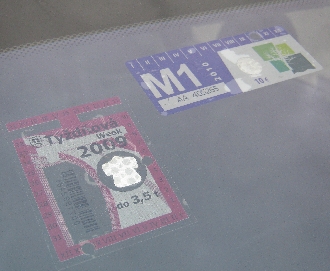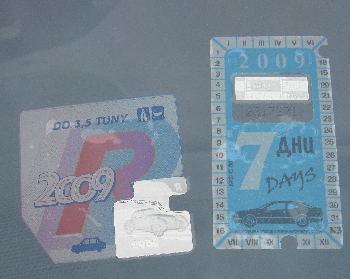We bid farewell to our couchsurfing hosts in Istanbul on the morning of Monday 19th October and set out on a two day drive to reach Montenegro. Using the older of the two suspension bridges that span the Bosphorus, we crossed into European Turkey and headed out of the city on the motorway that leads to the border with Bulgaria.
Once out of the immediate urban confines of Istanbul, the motorway is subject to toll. On entering the section subject to toll, there is a barrier where you obtain a ticket that shows the date, time and location where you joined the motorway. When you leave the motorway or reach the end of the section subject to toll, you present your ticket at another barrier and pay the appropriate fee. Motorway tolls are collected in the same manner in Serbia and Croatia as they also are in France, Spain and Italy.
However, many other European countries that charge motorists for the use of their motorways do so by means of a ‘vignette’. A ‘vignette’ is a sticker, usually purchased from a roadside shop or garage, indicating that the appropriate road toll has been paid for a certain period of time which can range from a few days to one year. Cameras and random police checks are used to enforce compliance.
Whilst the system is good in principle, it does mean that if you drive in and through as many countries as we have in 2009, you end up with a windscreen full of vignette stickers! Different countries require vignettes to be displayed in different locations on car windscreens meaning that we now have stickers in three separate places!
 |
 |

On reaching the Turkish-Bulgarian border, we began retracing our steps, travelling the same route across Bulgaria as we had used for our outward journey but in the reverse direction. We continued along this same route in reverse as far as Niš in southern Serbia where we once more stayed overnight. The following day, we ventured into new territory, wending our way across southern Serbia towards Montenegro.
I deliberately chose a route through southern Serbia that avoided passing into Kosovo as the car is only insured to be driven in ‘those parts of Serbia under the control of the government of Serbia’. Our route therefore took us through the mountains of the Kopaonik National Park just north of the Serbia-Kosovo border.
Only three days earlier, we had been experiencing daytime temperatures in excess of 25 degrees Celsius. It had become much cooler ever since passing through a series of thunderstorms as we drove into Istanbul. But as we climbed into the mountains of the Kopaonik National Park, through ever increasingly attractive scenery, the temperature dropped sharply and, much to our surprise, we found ourselves surrounded by the first snowfall of the winter. Fortunately, the road had been cleared which allowed us to cross the mountains, drop down the other side and make our way to the border with Montenegro.


